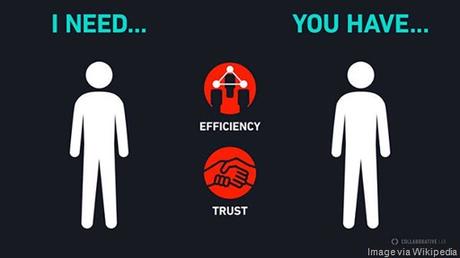 As dialogs with peers become easier and more trusted via smartphones and the Internet, people are more willing to share their assets with others, and capitalize on the potential for a quick return for very little effort. This new sharing economy is rapidly becoming the new “online shopping” model, with major winners already including Airbnb (rooms), Uber (rides), and SnapGoods (stuff).
As dialogs with peers become easier and more trusted via smartphones and the Internet, people are more willing to share their assets with others, and capitalize on the potential for a quick return for very little effort. This new sharing economy is rapidly becoming the new “online shopping” model, with major winners already including Airbnb (rooms), Uber (rides), and SnapGoods (stuff).
Experts are calling this the “we” economy, instead of “me.” It seems like a simple movement, but like any change in business, there are some new best practices that you need to learn, to make it work for you. Here are tips to keep your business from landing on the failure heap, like Carpooling.com (long-distance ridesharing), Beepi (used cars), and Homejoy (home services):
- Provide relationship building opportunities for your customers. Customers today expect two-way relationships with the companies they choose, rather than transactions. To facilitate this, your team must use and embrace available interactive communication modes, including social media, blogging, web site forums, and special events.
-
Deliver personalized solutions and memorable experiences. The new demographic wants to provide input, and wants to be treated as one-of-a-kind in their solution, delivery, and service. The days of mass production and commodity pricing as an asset are gone. Being good in business now needs to feel like an art, with creativity and innovation.
-
Build your market by focusing locally before globally. Narrowing your initial focus actually builds exclusivity and allows you to charge a premium because you are “the expert.” Start with a niche that you know especially well, and build a reputation of being the best. This will give you the credibility to expand to other niches and grow the market.
-
Develop a culture of innovation and creativity in your team. This requires leadership from the top on purpose and shared goals, and being the model for actively listening to customers and incenting change. Team members need to be taught to think like innovators, and see a reward system that fosters change, rather than punishing failures.
-
Let people be pulled to you, rather than pushed by marketing. Both customers and employees expect to see value beyond a product or service, especially for social and environmental good, as leading the way forward. The result is an enhanced loyalty, both inside and outside your company, which is a strong component of momentum and profit.
-
Communicate with stories and engaged customer advocates. Personal stories and testimonials are the best way to draw in customers and grow your business. Stories always trump marketing content for improving recollection and understanding. They help people remember in a way that numbers and text on a slide with a bar graph won’t.
-
Provide value to the community, as well as customers. If you provide real value and give-back to the global community and employees, thus generating trust and loyalty, you will appeal to more customers. The result is the desired win-win situation, with more profits for your business, more satisfied customers, and happy employees at all levels.
For example, on Instagram, Airbnb encourages users to use the hashtag #Airbnb in order to be featured on the company website. If the company likes your picture, it creates a post showing how, in this scenario, city dwellers easily belong to the swimming enthusiast community.
Uber and Lyft recognized that local regulations are different from region to region, so they launched market by market in order foster loyalty from their customers, maintain quality of the service, and comply with the region's laws.
This works especially well for services. In my own blog and speaking engagements, I talk about generic requirements to attract investors, but never mention that I offer a service to assist. Entrepreneurs are incented to followup with me for more specific fee offerings.
For example, Citi Bike is building themselves a great business by providing bicycles everywhere for sharing, but also is enhancing tourism and providing native New Yorkers with a fun and affordable new way to get around town.
The world of commerce has been forever altered by the growth of the world-wide Internet and pervasive mobile telecommunications. The customer and business universes are now globally and intimately connected. This means that all customers see relationships, culture, sharing, and social needs as part of their own world, and expect these to be part of every business focus.
Thus, as the new sharing economy challengers continue to evolve their new business models, the traditional incumbents will be smart to adapt, or forced out of the marketplace. It’s time to take a reading on where your business is in this spectrum. Are your company practices consistent with the ones outlined here, or are you still operating on yesterday’s model?

